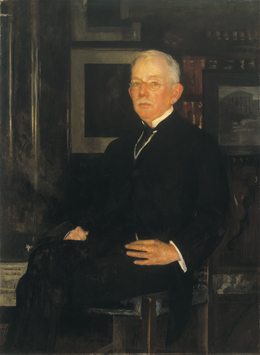At the end of my trip along the Erie Canal I had the chance
to spend some time exploring Buffalo, New York, and to stop at the Corning
Museum of Glass, in corning New York. I had not visited Buffalo in about 45
years, and I was impressed with some of the things I got to see.
Albright-Knox Gallery

By Danielle Sauers (Own work) [CC BY-SA 3.0 (http://creativecommons.org/licenses/by-sa/3.0)], via Wikimedia Commons

I started my day in Buffalo with a visit to the Albright-Knox Art Gallery. Located
across from the entrance of Buffalo State College, and alongside the Fredrick
Law Olmsted designed Delaware Park, Albright-Knox’s classical and modern buildings
are a beautiful home to its collection of Modern and Contemporary Art. Its
original building was built in 1905 as the home to the collection of modern art
owned by John J.
Albright, a Buffalo industrialist whose businesses included coal, asphalt
and electrical power. In 1962 Seymour Knox II, chairman of the Marine Midland
Bank and Woolworth’s & Co. organized the funding for an expansion of the
gallery. He donated over 700 pieces of art, and the name was changed to The
Albright Knox Art Gallery. His interest was mostly in Modernism and
Abstractionism, and he greatly added pieces in those genres to the galleries’
collections.
Today the Gallery hosts an excellent collection of 20th
and 21st Century art, mostly on display in the building built in
1962. The original building houses galleries that are primarily used to host temporary
exhibits by artists alive today.
 |
| Detail from Someday We Can by Shantell Martin |
Along the Niagara River
The heart of Buffalo’s history is its role in shipping and
transportation. It sits at the head of the Niagara River, along the shore of
Lake Erie. It was the western terminus of the original Erie Canal, so it became
the place where goods were transferred between lake ships and canal barges. It
also became an industrial center because it is so close to the Niagara Falls,
where Thomas Edison built one of the first large hydroelectric generating
plants. By the late 1950’s things started to change. The St. Lawrence Seaway
opened in 1957, and ocean going ships were able to sail directly into the Great
Lakes. The Erie Canal was no longer needed to ship goods to and from the Mid-West.
During the 1960’s industry started to leave what is today called the “Rust Belt”
for other places. Buffalo became one of the poorest cities in the country.
Today Buffalo is trying to revitalize itself. This effort
includes the development of its waterfront, much of which had been cut off from
the city by highways. The most successful of these attempts is Canalside Park, which sits under
the Buffalo Skyway at Lloyd Street. Built along what was the western end of the
original Erie Canal. Canalside includes lakeside walking and biking trails,
kayak and boat rentals, and a ferry across the Buffalo River to the Times Beach
Nature Preserve. There is also the Buffalo
and Erie County Naval and Military Park. The Park is home to the guided
missile cruiser U.S.S. Little Rock, the destroyer U.S.S. The Sullivans, and the
U.S.S. Croaker, a Gato-class submarine. All are open to the public. There is
also a naval history museum and a very good restaurant – The Liberty Hound,
which has an excellent selection of beer on tap.
Frank Lloyd Wright Boathouse
Two-and-a-half miles north of Canalside, along the Black Rock
Canal, is a small, little known gem – a boathouse designed by Frank Lloyd Wright.
Designed in 1905, the boathouse wasn’t constructed until 2007. I sits just south
of the Peace Bridge, the major crossing between Canada and Buffalo. There is
also a path up to a pavilion that sits just below the bridge, with great views
up and down the Niagara River.
The Corning Museum of Glass – Corning NY
Home to both the history and future of all things glass, The Corning Museum of Glass is really a must see
stop if you are traveling along the Southern Tier of New York State. Presenting
both industrial and artistic uses and histories, its exhibits and galleries are
informative and beautiful. There are exhibits into the history of industrial glass
that cover its different uses and strengths. You can watch artists creating
glass vases and bowls and doing fine “fire work” to make detailed statues. You
can take classes in glass blowing, and even design a piece that the artisans
will create for you. The galleries contain some of the most beautiful examples
of glass as art in the world.
 |
| Glass Blowing Demo |
 |
| Nocturne 5 by Karen LaMonte |
 |
| Chess Set by Gianni Tosso Jews vs Catholics - I saw this set for sale when I visited Venice 20 years ago |
Getting There:
Albright-Knox Art
Gallery – 1285 Elmwood
Ave. Buffalo NY. Entry -$12 for Adults, $8 for seniors, veterans, students and
youths.
Canalside Buffalo – 44 Prime Street, Buffalo NY.
Interstate 190 to Elm Street (exit 6); or Skyway/Route 5 to Seneca Street; or
NAFTA Metro Rail to the Erie Canal Harbor Station.
Wright Boathouse – Take Porter Ave west. Pass the
entrance to the Peace Bridge, and cross over I-190. Turn right onto Rotary Row,
and gravel street that looks like an alley. Bear right at the fork and you will
arrive at the parking lot for the Westside Rowing Club and the Wright
Boathouse.
Corning Museum of Glass
– Take Route NY-17(I-86)
to exit 46. Follow the signs to the Museum. Adults $19.50, Students, seniors,
AAA, and military $16.50.













Interesting reading about these places. I went to school in Buffalo but had no transportation and little time to explore. Thanks for taking me on this journey. AMD
ReplyDelete